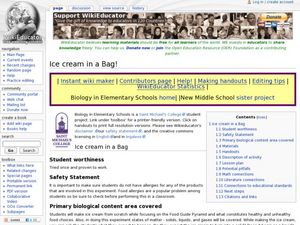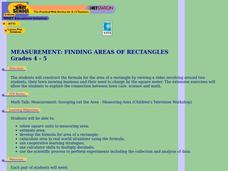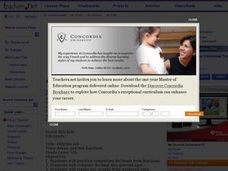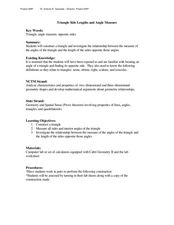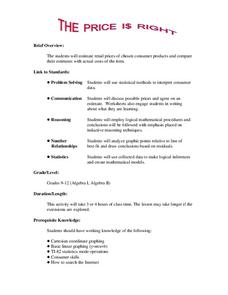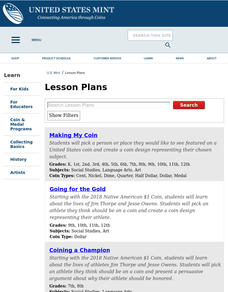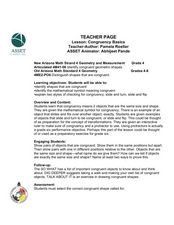Curated OER
Absolute Maximum and Minimum
Students calculate the maximum and minimum of each function. In this algebra lesson, students collect and graph data to analyze it. They differentiate between the absolute max and min and the maxima and minima of each function.
Curated OER
Do You Feel Lucky?
Students calculate simple probabilities using mathematics then roll dice to test their predictions.
Curated OER
Jelly Belly: What a Wonderful "Bean"!
Students explore how jelly beans are produced. They discuss the origins of the jelly bean and view a video about how jelly beans are prepared, tested, shaped, finished, and shipped and estimate the amount of jelly beans in a jar and sort...
Curated OER
Discovering the Linear Relationship between Celsius and Fahrenheit
Middle schoolers discover the linear relationship between degrees Farenheit and degrees Celsius. They manually compute the slope and y-intercept of the line passing through points. They convert Celsius to Fahrenheit degrees.
Curated OER
Probability & Game Theory
Students explore the concept of probability. In this probability lesson, students perform various probability experiments including flipping a coin, picking m&m's out of a bag, and the birthday problem.
Curated OER
Ice Cream in a Bag!
Students follow a recipe to make ice cream. In this ice cream lesson plan, students make their own ice cream by measuring out ingredients and following directions.
Curated OER
Inverse Variation
In this algebra worksheet, students find the inverse of an equations. They graph their solutions and analyze it. There are 8 questions.
Curated OER
It All Adds Up
Students brainstorm reasons for politicians to expand recycling programs and find statistics to support recycling programs. They design posters, displaying a compelling statistic about recycling, to convince students at their school to...
Curated OER
Measurement: Finding Areas of Rectangles
Pupils construct the formula for the area of a rectangle.
Curated OER
Skittles Lab
Students use Skittles as manipulatives to practice computing decimals from fractions, computing decimals into percentages, and creating bar graphs from gathered data.
Curated OER
Arrays And Factors
Students participate in a lesson that is concerned with the concepts of arrays and factors. They use a Hershey bar and divide it into segments in order to simulate the arrays. Then students construct other arrays from the leftover pieces.
Curated OER
Triangle Side Lengths and Angles Measures
Students identify missing sides and angles. In this geometry lesson, students use triangular theorems to identify the missing sides. They use the Pythagorean Theorem to find the different ratios of each side.
Curated OER
A Mars Bar Fraction Hunt Lesson for Grades 3-5
Students use their knowledge of fractions to decipher word puzzles. In this fraction lesson, students use common fractional parts to divide words into the letters needed to make a new word. They complete 28 examples to find a clue that...
Curated OER
The Price Is Right
Students create a list of products with estimated prices. In this algebra lesson plan, students learn to write equations using variables. They match their created list with that of actual products and compare their prices,
Curated OER
The Box Problem
Students investigate the concept of functions and how they are used with polynomials. They practice finding the zeros of functions and graph polynomial functions for the help of giving solutions. Students interpret the curve of a line...
Curated OER
A Unified China
Pupils examine the major changes Qin accomplished as emperor. They look at his steps to unify China, create a money standard, measurement standards, and a system of bureaucracy.
Pennsylvania Department of Education
Introducing the Coordinate Plane
Fifth graders practice using estimation. In this estimation instructional activity, 5th graders add, subtract, multiple, and divide using whole numbers, fractions, and decimals. Students decide upon instances when estimation is more...
Curated OER
The M&M's Brand Chocolate Candies Counting Book
First graders use estimation skills and gather data and record their findings
Curated OER
You're the Cashier!
Third graders use manipulatives and computers to count back change from amounts up to $5.00.
Curated OER
Graphs and Functions
Students are introduced to plotting functions on the Cartesian coordinate plane seen several categories of functions, including lines and parabolas
Curated OER
Function Machine
Second graders decipher a pattern using input and output. In this functions activity, 2nd graders use input and output numbers to find a pattern involving addition and subtraction. Students use the pattern they discovered to help solve...
Curated OER
Odd Is In
Pupils play a game with coins and then use reasoning skills to develop a strategy for winning the game.
Curated OER
Congruency Basics
Fourth graders investigate congruent shapes. For this congruency lesson, 4th graders explore examples of congruent shapes. Students determine how to check for congruency by sliding or flipping the shape.
Curated OER
Angle Action
Students measure and label specified angles. In this angles lesson plan, students use a protractor to find angles that are acute, obtuse, and reflexive. Students then label each angle and match the angles the correct definition. This...







